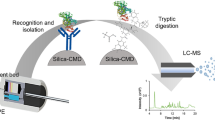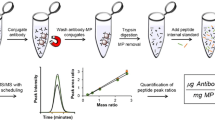Abstract
Silane-immobilized magnetic iron oxide particles were used as the assisting material in surface-assisted laser desorption/ionization (SALDI) mass spectrometric analysis. This approach can be used to analyze small proteins and peptides. The upper detectable mass range is approximately 16 kDa. The detection limit for peptides is about 20 fmol. Silanized iron oxide particles with negatively charged functionalities can also be used as the affinity probes to selectively trap oppositely charged species from sample solutions by adjusting the pH of the solution. A tryptic digest product of cytochrome C at a concentration as low as 10 nM can be enriched by the particles and directly analyzed by iron oxide SALDI MS without the need for elution steps. Affinity-based mass spectrometry using the bifunctional silanized magnetic iron oxide particles as the SALDI matrix and concentrating probe is demonstrated in this study.








Similar content being viewed by others
Rererences
Sunner J, Dratz E, Chen Y-C (1995) Anal Chem 67:4335–4342
Karas M, Bachmann D, Hillenkamp F (1985) Anal Chem 57:2935–2939
Karas M, Hillenkamp F (1988) Anal Chem 60:2299–2301
Tanaka K, Waki H, Ido Y, Akita S, Yoshida Y, Yoshida T (1988) Rapid Commun Mass Spectrom 2:151–153
Dale MJ, Knochenmuss R, Zenobi R (1996) Anal Chem 68:3321–3329
McLean JA, Stumpo KA, Russell DHJ (2005) Am Chem Soc 127:5304–5305
Hoang TT, Chen YF, May SW, Browner RF (2004) Anal Chem 76:2062–2070
Finkel NH, Prevo BG, Velev OD, He L (2005) Anal Chem 77:1088–1095
Schürenberg M, Dreisewerd K, Hillenkamp F (1999) Anal Chem 71:221–229
Chen C-T, Chen Y-C (2005) Anal Chem 77:5912–5919
Chen C-T, Chen Y-C (2004) Anal Chem 76:1453–1457
Chen C-T, Chen Y-C (2004) Rapid Commun Mass Spectrom 18:1956–1964
Chen W-Y, Wang L-S, Chiu H-T, Chen Y-C, Lee C-YJ (2004) Am Soc Mass Spectrom 15:1629–1635
Teng C-H, Ho K-C, Lin Y-S, Chen Y-C (2004) Anal Chem 76:4337–4342
Cao J, Wang Y, Yu J, Xia J, Zhang C, Yin D, Häfeli UO (2004) J Magn Magn Mater 277:165–174
Acknowledgements
The authors would like to thank the National Science Council of Taiwan for financial support.
Author information
Authors and Affiliations
Corresponding author
Rights and permissions
About this article
Cite this article
Chen, WY., Chen, YC. Affinity-based mass spectrometry using magnetic iron oxide particles as the matrix and concentrating probes for SALDI MS analysis of peptides and proteins. Anal Bioanal Chem 386, 699–704 (2006). https://doi.org/10.1007/s00216-006-0427-0
Received:
Revised:
Accepted:
Published:
Issue Date:
DOI: https://doi.org/10.1007/s00216-006-0427-0




